Synthesis of a Novel Series of Cu(I) Complexes Bearing Alkylated 1,3,5-Triaza-7-phosphaadamantane as Homogeneous and Carbon-Supported Catalysts for the Synthesis of 1- and 2-Substituted-1,2,3-triazoles
Abstract
:1. Introduction
2. Materials and Methods
2.1. General Procedures
2.2. Synthesis of PTA Ammonium Salts 1–3
2.3. Synthesis of the Complexes (4–7)
2.3.1. Synthesis of [Cu(PTA-Me)4]Br5 (4)
2.3.2. Synthesis of [CuBr2(PTA-CH2-m-NO2-C6H4)2]Br (5a)
2.3.3. Synthesis of [CuBr2(PTA-CH2-m-NO2-C6H4)2]I (5b)
2.3.4. Synthesis of [CuX(PTA-CH2-m-NO2-C6H4)3]Br3 (X = Br for 6a or I for 6b)
2.3.5. Synthesis of [CuBr2(PTA-CH2-p-NO2-C6H4)2]X (X = Br for 7a or I for 7b)
2.4. X-ray Structure Determination of Compounds 2, 4 and 5a
2.5. Treatments of the Carbon Materials
2.6. Heterogenization Protocol
2.7. Catalytic Essays
2.7.1. Synthesis of 1,4-disubstituted 1,2,3-triazole
2.7.2. Synthesis of N-hydroxymethyl-1,2,3-triazole
3. Results and Discussion
3.1. Synthesis and Characterization of the Compounds
3.2. X-ray Crystal Analysis of Compounds 2, 4 and 5a
3.3. Preparation and Characterization of the Carbon Materials
3.4. Heterogenization Efficiency
3.5. Catalytic Activity Study for the Azide-Alkyne Cycloaddition
3.5.1. Synthesis of 1,4-disubstituted 1,2,3-triazoles
3.5.2. Synthesis of N-hydroxymethyl-1,2,3-triazoles
4. Conclusions
Supplementary Materials
Author Contributions
Funding
Institutional Review Board Statement
Informed Consent Statement
Data Availability Statement
Acknowledgments
Conflicts of Interest
References
- Kolb, H.C.; Finn, M.G.; Sharpless, K.B. Click Chemistry: Diverse Chemical Function from a Few Good Reactions. Angew. Chem. Int. Ed. 2001, 40, 2004–2021. [Google Scholar] [CrossRef]
- Rostovtsev, V.V.; Green, L.G.; Fokin, V.V.; Sharpless, K.B. A Stepwise Huisgen Cycloaddition Process: Copper(I)-Catalyzed Regioselective “Ligation” of Azides and Terminal Alkynes. Angew. Chem. 2002, 114, 2708–2711. [Google Scholar] [CrossRef]
- Tornøe, C.W.; Christensen, C.; Meldal, M. Peptidotriazoles on Solid Phase: [1,2,3]-Triazoles by Regiospecific Copper(I)-Catalyzed 1,3-Dipolar Cycloadditions of Terminal Alkynes to Azides. J. Org. Chem. 2002, 67, 3057–3064. [Google Scholar] [CrossRef]
- Scriven, E.F.V.; Turnbull, K. Azides: Their Preparation and Synthetic Uses. Chem. Rev. 1988, 88, 297–368. [Google Scholar] [CrossRef]
- Bräse, S.; Gil, C.; Knepper, K.; Zimmermann, V. Organic Azides: An Exploding Diversity of a Unique Class of Compounds. Angew. Chem. Int. Ed. 2005, 44, 5188–5240. [Google Scholar] [CrossRef]
- Appukkuttan, P.; Dehaen, W.; Fokin, V.V.; Van Der Eycken, E. A Microwave-Assisted Click Chemistry Synthesis of 1,4-Disubstituted 1,2,3-Triazoles via a Copper(I)-Catalyzed Three-Component Reaction. Org. Lett. 2004, 6, 4223–4225. [Google Scholar] [CrossRef]
- Moses, J.E.; Moorhouse, A.D. The Growing Applications of Click Chemistry. Chem. Soc. Rev. 2007, 36, 1249–1262. [Google Scholar] [CrossRef] [PubMed]
- Binder, W.H.; Sachsenhofer, R. ‘Click’ Chemistry in Polymer and Materials Science. Macromol. Rapid Commun. 2007, 28, 15–54. [Google Scholar] [CrossRef]
- Li, L.; Zhang, Z. Development and Applications of the Copper-Catalyzed Azide-Alkyne Cycloaddition (CuAAC) as a Bioorthogonal Reaction. Molecules 2016, 21, 1393. [Google Scholar] [CrossRef] [PubMed]
- Chan, T.R.; Hilgraf, R.; Sharpless, K.B.; Fokin, V.V. Polytriazoles as Copper(I)-Stabilizing Ligands in Catalysis. Org. Lett. 2004, 6, 2853–2855. [Google Scholar] [CrossRef]
- Hong, V.; Presolski, S.I.; Ma, C.; Finn, M.G. Analysis and Optimization of Copper-Catalyzed Azide-Alkyne Cycloaddition for Bioconjugation. Angew. Chem. 2009, 121, 10063–10067. [Google Scholar] [CrossRef] [Green Version]
- Mahmoud, A.G.; Smolénski, P.; Guedes Da Silva, M.F.C.; Pombeiro, A.J.L. Water-Soluble O-, S-and Se-Functionalized Cyclic Acetyl-Triaza-Phosphines. Synthesis, Characterization and Application in Catalytic Azide-Alkyne Cycloaddition. Molecules 2020, 25, 5479. [Google Scholar] [CrossRef]
- Lal, S.; Díez-González, S. [CuBr(PPh3)3 ] for Azide−Alkyne Cycloaddition Reactions under Strict Click Conditions. J. Org. Chem. 2011, 76, 2367–2373. [Google Scholar] [CrossRef]
- Candelon, N.; Lastécouères, D.; Diallo, A.K.; Ruiz Aranzaes, J. A Highly Active and Reusable Copper(i)-Tren Catalyst for the “Click” 1,3-Dipolar Cycloaddition of Azides and Alkynes. Chem. Commun. 2008, 41, 741–743. [Google Scholar] [CrossRef]
- García-Álvarez, J.; Díez, J.; Gimeno, J. A Highly Efficient Copper(i) Catalyst for the 1,3-Dipolar Cycloaddition of Azides with Terminal and 1-Iodoalkynes in Water: Regioselective Synthesis of 1,4-Disubstituted and 1,4,5-Trisubstituted 1,2,3-Triazoles. Green Chem. 2010, 12, 2127–2130. [Google Scholar] [CrossRef]
- García-Álvarez, J.; Díez, J.; Gimeno, J.; Suárez, F.J.; Vincent, C. (Iminophosphorane)Copper(I) Complexes as Highly Efficient Catalysts for 1,3-Dipolar Cycloaddition of Azides with Terminal and 1-Iodoalkynes in Water: One-Pot Multi-Component Reaction from Alkynes and in Situ Generated Azides. Eur. J. Inorg. Chem. 2012, 2012, 5854–5863. [Google Scholar] [CrossRef]
- Díez-González, S.; Correa, A.; Cavallo, L.; Nolan, S.P. (NHC)Copper(I)-Catalyzed [3+2] Cycloaddition of Azides and Mono- Or Disubstituted Alkynes. Chem.-A Eur. J. 2006, 12, 7558–7564. [Google Scholar] [CrossRef] [PubMed]
- Díez-González, S.; Nolan, S.P. [(NHC)2Cu]X Complexes as Efficient Catalysts for Azide-Alkyne Click Chemistry at Low Catalyst Loadings. Angew. Chem. 2008, 120, 9013–9016. [Google Scholar] [CrossRef]
- Díez-González, S.; Stevens, E.D.; Nolan, S.P. A [(NHC)CuCl] Complex as a Latent Click Catalyst. Chem. Commun. 2008, 68, 4747–4749. [Google Scholar] [CrossRef]
- Özçubukçu, S.; Ozkal, E.; Jimeno, C.; Pericàs, M.A. A Highly Active Catalyst for Huisgen 1,3-Dipolar Cycloadditions Based on the Tris(Triazolyl)Methanol−Cu(I) Structure. Org. Lett. 2009, 11, 4680–4683. [Google Scholar] [CrossRef] [PubMed]
- Ozkal, E.; Özçubukçu, S.; Jimeno, C.; Pericàs, M.A. Covalently Immobilized Tris(Triazolyl)Methanol–Cu(i) Complexes: Highly Active and Recyclable Catalysts for CuAAC Reactions. Catal. Sci. Technol. 2012, 2, 195–200. [Google Scholar] [CrossRef]
- Mahmoud, A.G.; Martins, L.M.D.R.S.; Guedes da Silva, M.F.C.; Pombeiro, A.J.L. Copper Complexes Bearing C-Scorpionate Ligands: Synthesis, Characterization and Catalytic Activity for Azide-Alkyne Cycloaddition in Aqueous Medium. Inorg. Chim. Acta 2018, 483, 371–378. [Google Scholar] [CrossRef]
- Mahmoud, A.G.; Guedes da Silva, M.F.C.; Mahmudov, K.T.; Pombeiro, A.J.L. Arylhydrazone Ligands as Cu-Protectors and -Catalysis Promoters in the Azide–Alkyne Cycloaddition Reaction. Dalton Trans. 2019, 48, 1774–1785. [Google Scholar] [CrossRef]
- Guerriero, A.; Peruzzini, M.; Gonsalvi, L. Coordination Chemistry of 1,3,5-Triaza-7-Phosphatricyclo[3.3.1.1]Decane (PTA) and Derivatives. Part III. Variations on a Theme: Novel Architectures, Materials and Applications. Coord. Chem. Rev. 2018, 355, 328–361. [Google Scholar] [CrossRef]
- Mahmoud, A.G.; Guedes da Silva, M.F.C.; Pombeiro, A.J.L. 3,7-Diacetyl-1,3,7-Triaza-5-Phosphabicyclo[3.3.1]Nonane (DAPTA) and Derivatives: Coordination Chemistry and Applications. Coord. Chem. Rev. 2021, 429, 213614. [Google Scholar] [CrossRef]
- Mahmoud, A.G.; Guedes da Silva, M.F.C.; Sokolnicki, J.; Smoleński, P.; Pombeiro, A.J.L. Hydrosoluble Cu(I)-DAPTA Complexes: Synthesis, Characterization, Luminescence Thermochromism and Catalytic Activity for Microwave-Assisted Three-Component Azide-Alkyne Cycloaddition Click Reaction. Dalton Trans. 2018, 47, 7290–7299. [Google Scholar] [CrossRef]
- Mahmoud, A.G.; Guedes da Silva, M.F.C.; Śliwa, E.I.; Smoleński, P.; Kuznetsov, M.L.; Pombeiro, A.J.L. Copper(II) and Sodium(I) Complexes Based on 3,7-Diacetyl-1,3,7-triaza-5-phosphabicyclo[3.3.1]Nonane-5-oxide: Synthesis, Characterization, and Catalytic Activity. Chem. Asian J. 2018, 13, 2868–2880. [Google Scholar] [CrossRef]
- Librando, I.L.; Mahmoud, A.G.; Carabineiro, S.A.C.; Guedes da Silva, M.F.C.; Geraldes, C.F.G.C.; Pombeiro, A.J.L. The Catalytic Activity of Carbon-Supported Cu(I)-Phosphine Complexes for the Microwave-Assisted Synthesis of 1,2,3-Triazoles. Catalysts 2021, 11, 185. [Google Scholar] [CrossRef]
- Belskaya, N.; Subbotina, J.; Lesogorova, S. Synthesis of 2H-1,2,3-Triazoles. In Chemistry of 1,2,3-Triazoles; Dehaen, W., Bakulev, V.A., Eds.; Springer International Publishing: Cham, Switzerland, 2015; pp. 51–116. ISBN 978-3-319-07962-2. [Google Scholar]
- De Souza, R.O.M.A.; De Mariz e Miranda, L.S. Strategies Towards the Synthesis of N2-Substituted 1,2,3-Triazoles. An. Acad. Bras. Cienc. 2019, 91, 751. [Google Scholar] [CrossRef]
- Tome, A.C. Science of Synthesis; Stor, R., Gilchrist, T., Eds.; Thieme: New York, NY, USA, 2004; pp. 415–601. [Google Scholar]
- Hadjiantoniou-Maroulis, C.P.; Maroulis, A.J.; Terzis, A.; Mentzafos, D. 1,2,3-Triazol-1-Imines. 1. The Synthesis and Lead Tetraacetate Oxidation of Biacetyl Benzoylhydrazone Arylhydrazones to the Novel 2-Aryl-N-Benzoyl-4,5-Dimethyl-1,2,3-Triazol-1-Imines. J. Org. Chem. 1992, 57, 2252–2257. [Google Scholar] [CrossRef]
- Kamijo, S.; Jin, T.; Huo, Z.; Yamamoto, Y. Regiospecific Synthesis of 2-Allyl-1,2,3-Triazoles by Palladium-Catalyzed 1,3-Dipolar Cycloaddition. Tetrahedron Lett. 2002, 43, 9707–9710. [Google Scholar] [CrossRef]
- Kamijo, S.; Jin, T.; Huo, Z.; Yamamoto, Y. Synthesis of Triazoles from Nonactivated Terminal Alkynes via the Three-Component Coupling Reaction Using a Pd(0)−Cu(I) Bimetallic Catalyst. J. Am. Chem. Soc. 2003, 125, 7786–7787. [Google Scholar] [CrossRef]
- Iddon, B.; Nicholas, M. Azoles. Part 13. Synthesis and Bromine ? Lithium Exchange Reactions of Some 1-Substituted 4,5-Dibromo-1H-1,2,3-Triazoles and 2-Substituted 4,5-Dibromo-2H-1,2,3-Triazoles. J. Chem. Soc. Perkin Trans. 1996, 10, 1341–1347. [Google Scholar] [CrossRef]
- Katritzky, A.R.; Perumal, S.; Savage, G.P. An NMR Study of the Equilibria Involved with Benzotriazole, Carbonyl Compounds, and Their Adducts. J. Chem. Soc. Perkin Trans. 1990, 2, 921–924. [Google Scholar] [CrossRef]
- Alkorta, I.; Elguero, J.; Jagerovic, N.; Fruchier, A.; Yap, G.P.A. Study of the Structure of 1-Hydroxymethylindazole and 1-Hydroxymethylbenzotriazole by X-Ray Crystallography, Multinuclear NMR in Solution and DFT Calculations. J. Heterocycl. Chem. 2004, 41, 285–289. [Google Scholar] [CrossRef]
- Kalisiak, J.; Sharpless, K.B.; Fokin, V.V. Efficient Synthesis of 2-Substituted-1,2,3-Triazoles. Org. Lett. 2008, 10, 3171–3174. [Google Scholar] [CrossRef] [PubMed]
- Liu, Y.; Yan, W.; Chen, Y.; Petersen, J.L.; Shi, X. Efficient Synthesis of N-2-Aryl-1,2,3-Triazole Fluorophores via Post-Triazole Arylation. Org. Lett. 2008, 10, 5389–5392. [Google Scholar] [CrossRef]
- Yan, W.; Wang, Q.; Lin, Q.; Li, M.; Petersen, J.L.; Shi, X. N-2-Aryl-1,2,3-Triazoles: A Novel Class of UV/Blue-Light-Emitting Fluorophores with Tunable Optical Properties. Chem.–A Eur. J. 2011, 17, 5011–5018. [Google Scholar] [CrossRef]
- Mahmoud, A.G.; Guedes da Silva, M.F.C.; Pombeiro, A.J.L. A New Amido-Phosphane as Ligand for Copper and Silver Complexes. Synthesis, Characterization and Catalytic Application for Azide–Alkyne Cycloaddition in Glycerol. Dalton Trans. 2021, 50, 6109–6125. [Google Scholar] [CrossRef]
- Atrián-Blasco, E.; Gascón, S.; Rodríguez-Yoldi, M.J.; Laguna, M.; Cerrada, E. Synthesis of Gold(I) Derivatives Bearing Alkylated 1,3,5-Triaza-7-Phosphaadamantane as Selective Anticancer Metallodrugs. Eur. J. Inorg. Chem. 2016, 2016, 2791–2803. [Google Scholar] [CrossRef] [Green Version]
- Bruker. APEX2; Bruker AXS Inc.: Madison, WI, USA, 2012. [Google Scholar]
- Sheldrick, G.M.; SADABS. Program for Empirical Absorption Correction; University of Gottingen: Göttingen, Germany, 2000. [Google Scholar]
- Altomare, A.; Burla, M.C.; Camalli, M.; Cascarano, G.L.; Giacovazzo, C.; Guagliardi, A.; Moliterni, A.G.G.; Polidori, G.; Spagna, R. SIR 97: A New Tool for Crystal Structure Determination and Refinement. J. Appl. Crystallogr. 1999, 32, 115–119. [Google Scholar] [CrossRef]
- Sheldrick, G.M. IUCr A Short History of SHELX. Acta Crystallogr. Sect. Found. Crystallogr. 2008, 64, 112–122. [Google Scholar] [CrossRef] [Green Version]
- Farrugia, L.J. WinGX and ORTEP for Windows: An Update. J. Appl. Crystallogr. 2012, 45, 849–854. [Google Scholar] [CrossRef]
- Martins, L.M.D.R.S.; Ribeiro, A.P.C.; Carabineiro, S.A.C.; Figueiredo, J.L.; Pombeiro, A.J.L. Highly Efficient and Reusable CNT Supported Iron(Ii) Catalyst for Microwave Assisted Alcohol Oxidation. Dalton Trans. 2016, 45, 6816–6819. [Google Scholar] [CrossRef] [Green Version]
- Ribeiro, A.P.D.C.; Martins, L.M.D.R.D.S.; Carabineiro, S.A.C.; Figueiredo, J.L.; Pombeiro, A.J.L. Gold Nanoparticles Deposited on Surface Modified Carbon Xerogels as Reusable Catalysts for Cyclohexane C-H Activation in the Presence of CO and Water. Molecules 2017, 22, 603. [Google Scholar] [CrossRef] [Green Version]
- Ribeiro, A.P.C.; Martins, L.M.D.R.S.; Carabineiro, S.A.C.; Figueiredo, J.L.; Pombeiro, A.J.L. Gold Nanoparticles Deposited on Surface Modified Carbon Materials as Reusable Catalysts for Hydrocarboxylation of Cyclohexane. Appl. Catal. A Gen. 2017, 547, 124–131. [Google Scholar] [CrossRef]
- De Almeida, M.P.; Martins, L.M.D.R.S.; Carabineiro, S.A.C.; Lauterbach, T.; Rominger, F.; Hashmi, A.S.K.; Pombeiro, A.J.L.; Figueiredo, J.L. Homogeneous and Heterogenised New Gold C-Scorpionate Complexes as Catalysts for Cyclohexane Oxidation. Catal. Sci. Technol. 2013, 3, 3056–3069. [Google Scholar] [CrossRef] [Green Version]
- Sutradhar, M.; Martins, L.M.D.R.S.; Carabineiro, S.A.C.; Guedes da Silva, M.F.C.; Buijnsters, J.G.; Figueiredo, J.L.; Pombeiro, A.J.L. Oxidovanadium(V) Complexes Anchored on Carbon Materials as Catalysts for the Oxidation of 1-Phenylethanol. ChemCatChem 2016, 8, 2254–2266. [Google Scholar] [CrossRef]
- Mahata, N.; Pereira, M.F.R.; Suárez-García, F.; Martínez-Alonso, A.; Tascón, J.M.D.; Figueiredo, J.L. Tuning of Texture and Surface Chemistry of Carbon Xerogels. J. Colloid Interface Sci. 2008, 324, 150–155. [Google Scholar] [CrossRef]
- Wang, J.; Martins, L.M.D.R.S.; Ribeiro, A.P.C.; Carabineiro, S.A.C.; Figueiredo, J.L.; Pombeiro, A.J.L. Supported C-Scorpionate Vanadium(IV) Complexes as Reusable Catalysts for Xylene Oxidation. Chem. Asian J. 2017, 12, 1915–1919. [Google Scholar] [CrossRef]
- Shaygan Nia, A.; Rana, S.; Döhler, D.; Jirsa, F.; Meister, A.; Guadagno, L.; Koslowski, E.; Bron, M.; Binder, W.H. Carbon-Supported Copper Nanomaterials: Recyclable Catalysts for Huisgen [3+2] Cycloaddition Reactions. Chem. Eur. J. 2015, 21, 10763–10770. [Google Scholar] [CrossRef]
- Maia, F.; Mahata, N.; Jarrais, B.; Silva, A.R.; Pereira, M.F.R.; Freire, C.; Figueiredo, J.L. Jacobsen Catalyst Anchored onto Modified Carbon Xerogel as Enantioselective Heterogeneous Catalyst for Alkene Epoxidation. J. Mol. Catal. Chem. 2009, 305, 135–141. [Google Scholar] [CrossRef]
- Martins, L.M.D.R.S.; De Almeida, M.P.; Carabineiro, S.A.C.; Figueiredo, J.L.; Pombeiro, A.J.L. Heterogenisation of a C-Scorpionate FeII Complex on Carbon Materials for Cyclohexane Oxidation with Hydrogen Peroxide. ChemCatChem 2013, 5, 3847–3856. [Google Scholar] [CrossRef]
- Tisato, F.; Refosco, F.; Porchia, M.; Tegoni, M.; Gandin, V.; Marzano, C.; Pellei, M.; Papini, G.; Lucato, L.; Seraglia, R.; et al. The Relationship between the Electrospray Ionization Behaviour and Biological Activity of Some Phosphino Cu(I) Complexes. Rapid Commun. Mass Spectrom. 2010, 24, 1610–1616. [Google Scholar] [CrossRef]
- Tisato, F.; Crociani, L.; Porchia, M.; Bernardo, P.D.; Endrizzi, F.; Santini, C.; Seraglia, R. The Relationship between Electrospray Ionization Behavior and Cytotoxic Activity of [MI(P)4]+-Type Complexes (M = Cu, Ag and Au; P = Tertiary Phosphine). Rapid Commun. Mass Spectrom. 2013, 27, 2019–2027. [Google Scholar] [CrossRef]
- Siegert, U.; Hahn, H.; Lang, H. Investigation of the Solution Behavior of Tri-n-Butylphosphine Copper(I) and Silver(I) Acetates Using 31P{1H} NMR Spectroscopy. Inorg. Chim. Acta 2010, 363, 944–948. [Google Scholar] [CrossRef]
- Yang, L.; Powell, D.R.; Houser, R.P. Structural Variation in Copper(i) Complexes with Pyridylmethylamide Ligands: Structural Analysis with a New Four-Coordinate Geometry Index, τ4. Dalton Trans. 2007, 36, 955–964. [Google Scholar] [CrossRef]
- Gerber, I.; Oubenali, M.; Bacsa, R.; Durand, J.; Gonçalves, A.; Pereira, M.F.R.; Jolibois, F.; Perrin, L.; Poteau, R.; Serp, P. Theoretical and Experimental Studies on the Carbon-Nanotube Surface Oxidation by Nitric Acid: Interplay between Functionalization and Vacancy Enlargement. Chem.-A Eur. J. 2011, 17, 11467–11477. [Google Scholar] [CrossRef]
- Figueiredo, J.L.; Pereira, M.F.R.; Freitas, M.M.A.; Órfão, J.J.M. Modification of the Surface Chemistry of Activated Carbons. Carbon N. Y. 1999, 37, 1379–1389. [Google Scholar] [CrossRef]
- Fuerte, A.; Iglesias, M.; Sánchez, F. New Chiral Diphosphinites: Synthesis of Rh Complexes. Heterogenisation on Zeolites. J. Organomet. Chem. 1999, 588, 186–194. [Google Scholar] [CrossRef]
- Serp, P.; Corrias, M.; Kalck, P. Carbon Nanotubes and Nanofibers in Catalysis. Appl. Catal. Gen. 2003, 253, 337–358. [Google Scholar] [CrossRef]
- Martínez, M.T.; Callejas, M.A.; Benito, A.M.; Cochet, M.; Seeger, T.; Ansón, A.; Schreiber, J.; Gordon, C.; Marhic, C.; Chauvet, O.; et al. Sensitivity of Single Wall Carbon Nanotubes to Oxidative Processing: Structural Modification, Intercalation and Functionalisation. Carbon N. Y. 2003, 41, 2247–2256. [Google Scholar] [CrossRef]
- Romanos, G.E.; Likodimos, V.; Marques, R.R.N.; Steriotis, T.A.; Papageorgiou, S.K.; Faria, J.L.; Figueiredo, J.L.; Silva, A.M.T.; Falaras, P. Controlling and Quantifying Oxygen Functionalities on Hydrothermally and Thermally Treated Single-Wall Carbon Nanotubes. J. Phys. Chem. C 2011, 115, 8534–8546. [Google Scholar] [CrossRef]
- Carabineiro, S.A.C.; Martins, L.M.D.R.S.; Pombeiro, A.J.L.; Figueiredo, J.L. Commercial Gold(I) and Gold(III) Compounds Supported on Carbon Materials as Greener Catalysts for the Oxidation of Alkanes and Alcohols. ChemCatChem 2018, 10, 1804–1813. [Google Scholar] [CrossRef]
- Prado-Burguete, C.; Linares-Solano, A.; Rodríguez-Reinoso, F.; de Lecea, C.S.M. The Effect of Oxygen Surface Groups of the Support on Platinum Dispersion in Pt/Carbon Catalysts. J. Catal. 1989, 115, 98–106. [Google Scholar] [CrossRef]
- Solhy, A.; Machado, B.F.; Beausoleil, J.; Kihn, Y.; Gonçalves, F.; Pereira, M.F.R.; Órfão, J.J.M.; Figueiredo, J.L.; Faria, J.L.; Serp, P. MWCNT Activation and Its Influence on the Catalytic Performance of Pt/MWCNT Catalysts for Selective Hydrogenation. Carbon N. Y. 2008, 46, 1194–1207. [Google Scholar] [CrossRef]
- Barros, E.B.; Filho, A.G.S.; Lemos, V.; Filho, J.M.; Fagan, S.B.; Herbst, M.H.; Rosolen, J.M.; Luengo, C.A.; Huber, J.G. Charge Transfer Effects in Acid Treated Single-Wall Carbon Nanotubes. Carbon N. Y. 2005, 43, 2495–2500. [Google Scholar] [CrossRef]
- Buckley, B.R.; Butterworth, R.; Dann, S.E.; Heaney, H.; Stubbs, E.C. “Copper-in-Charcoal” Revisited: Delineating the Nature of the Copper Species and Its Role in Catalysis. ACS Catal. 2014, 5, 793–796. [Google Scholar] [CrossRef] [Green Version]
- Nia, A.S.; Rana, S.; Döhler, D.; Noirfalise, X.; Belfiore, A.; Binder, W.H. Click Chemistry Promoted by Graphene Supported Copper Nanomaterials. Chem. Commun. 2014, 50, 15374–15377. [Google Scholar] [CrossRef] [Green Version]
- Nasrollahzadeh, M.; Jaleh, B.; Fakhri, P.; Zahraei, A.; Ghadery, E. Synthesis and Catalytic Activity of Carbon Supported Copper Nanoparticles for the Synthesis of Aryl Nitriles and 1,2,3-Triazoles. RSC Adv. 2015, 5, 2785–2793. [Google Scholar] [CrossRef]
- Himo, F.; Lovell, T.; Hilgraf, R.; Rostovtsev, V.V.; Noodleman, L.; Sharpless, K.B.; Fokin, V.V. Copper(I)-Catalyzed Synthesis of Azoles. DFT Study Predicts Unprecedented Reactivity and Intermediates. J. Am. Chem. Soc. 2005, 127, 210–216. [Google Scholar] [CrossRef]
- Rodionov, V.O.; Fokin, V.V.; Finn, M.G. Mechanism of the Ligand-Free CuI-Catalyzed Azide-Alkyne Cycloaddition Reaction. Angew. Chem. 2005, 117, 2250–2255. [Google Scholar] [CrossRef]
- Valentin, O.R.; Stanislav, I.P.; David, D.D.; Valery, V.F.; Finn, M.G. Ligand-Accelerated Cu-Catalyzed Azide−Alkyne Cycloaddition: A Mechanistic Report. J. Am. Chem. Soc. 2007, 129, 12705–12712. [Google Scholar] [CrossRef]
- Straub, B.F. μ-Acetylide and μ-Alkenylidene Ligands in “Click” Triazole Syntheses. Chem. Commun. 2007, 69, 3868–3870. [Google Scholar] [CrossRef]
- Özen, C.; Tüzün, N.Ş. The Mechanism of Copper-Catalyzed Azide-Alkyne Cycloaddition Reaction: A Quantum Mechanical Investigation. J. Mol. Graph. Model. 2012, 34, 101–107. [Google Scholar] [CrossRef]
- Baxter, C.W.; Higgs, T.C.; Bailey, P.J.; Parsons, S.; McLachlan, F.; McPartlin, M.; Tasker, P.A. Copper(I) Alkynyl Clusters, [Cux+y(Hfac)x(C≡CR)y], with Cu10-Cu12 Cores. Chem.-A Eur. J. 2006, 12, 6166–6174. [Google Scholar] [CrossRef]
- Ben El Ayouchia, H.; Bahsis, L.; Anane, H.; Domingo, L.R.; Stiriba, S.E. Understanding the Mechanism and Regioselectivity of the Copper(i) Catalyzed [3 + 2] Cycloaddition Reaction between Azide and Alkyne: A Systematic DFT Study. RSC Adv. 2018, 8, 7670–7678. [Google Scholar] [CrossRef] [Green Version]
- Berg, R.; Straub, B.F. Advancements in the Mechanistic Understanding of the Copper-Catalyzed Azide-Alkyne Cycloaddition. Beilstein J. Org. Chem. 2013, 9, 2715–2750. [Google Scholar] [CrossRef] [Green Version]
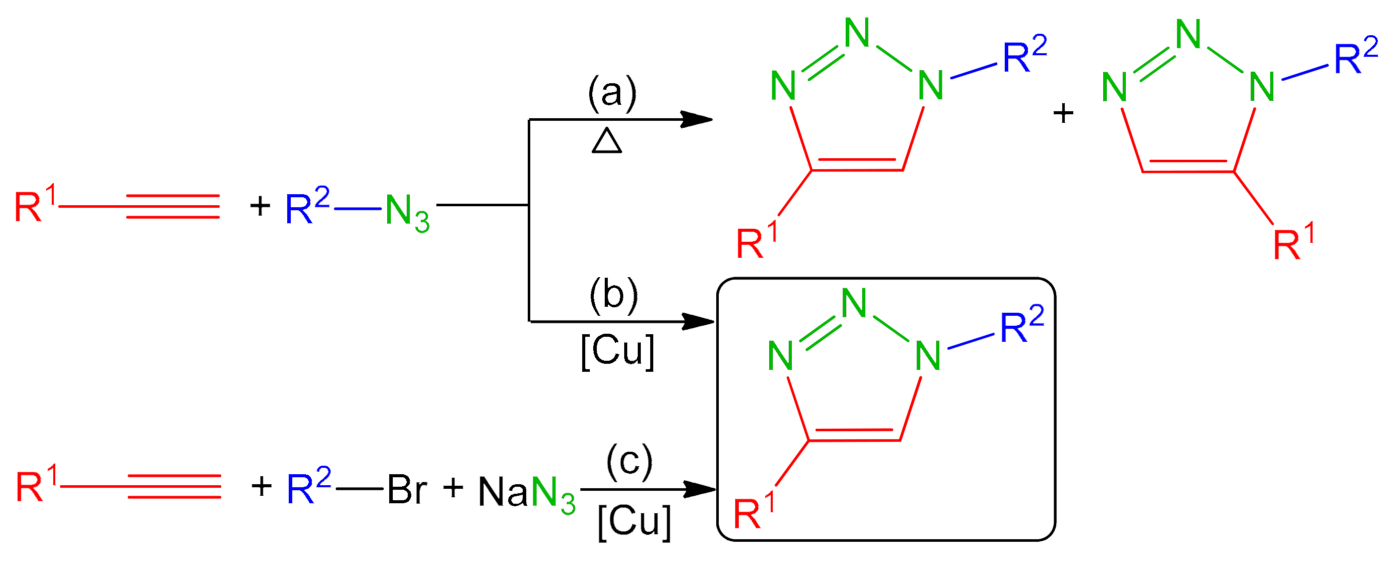


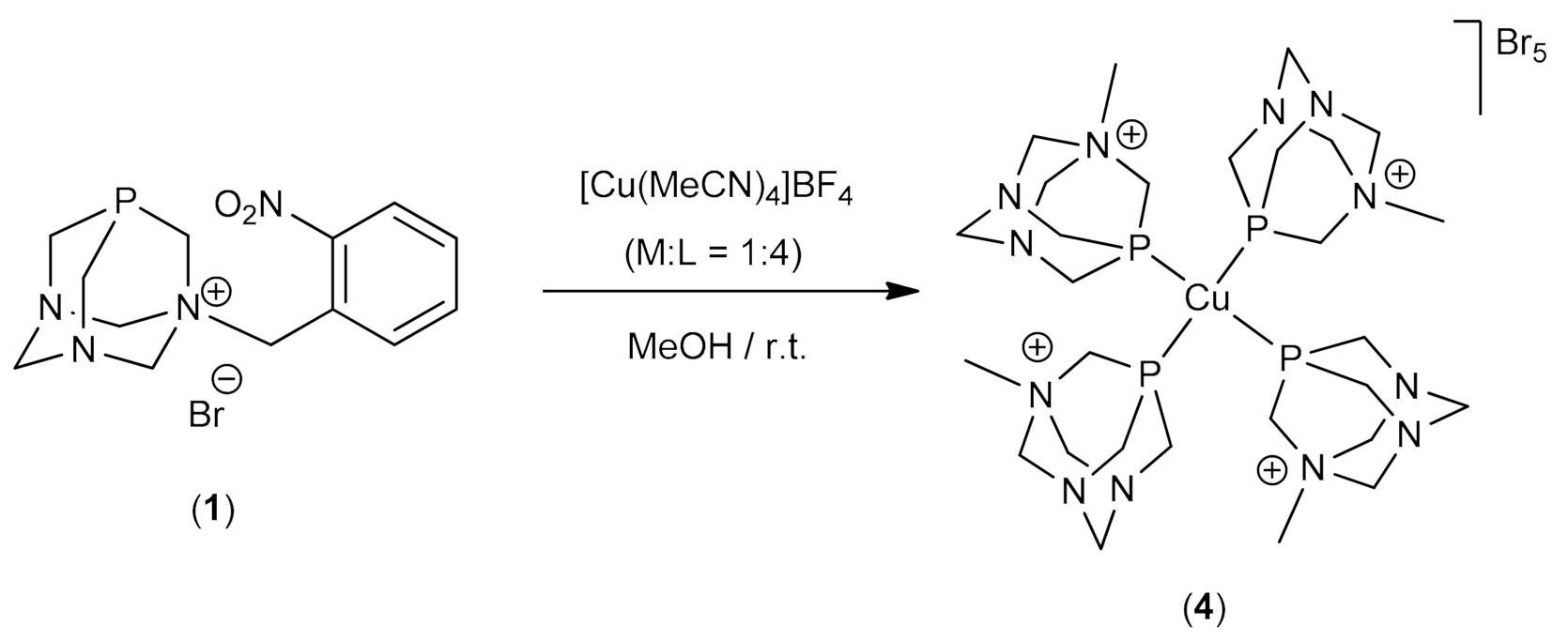
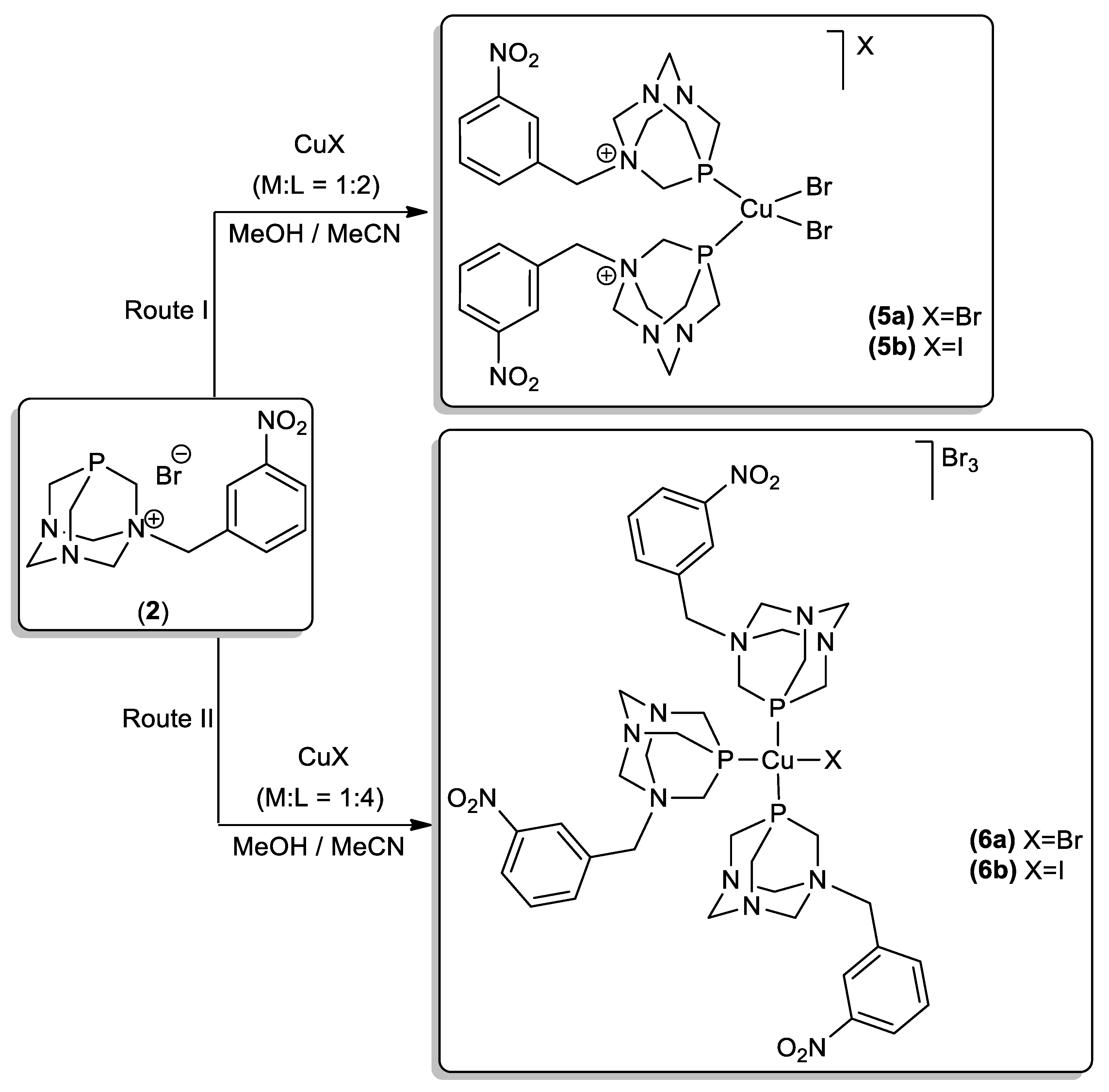


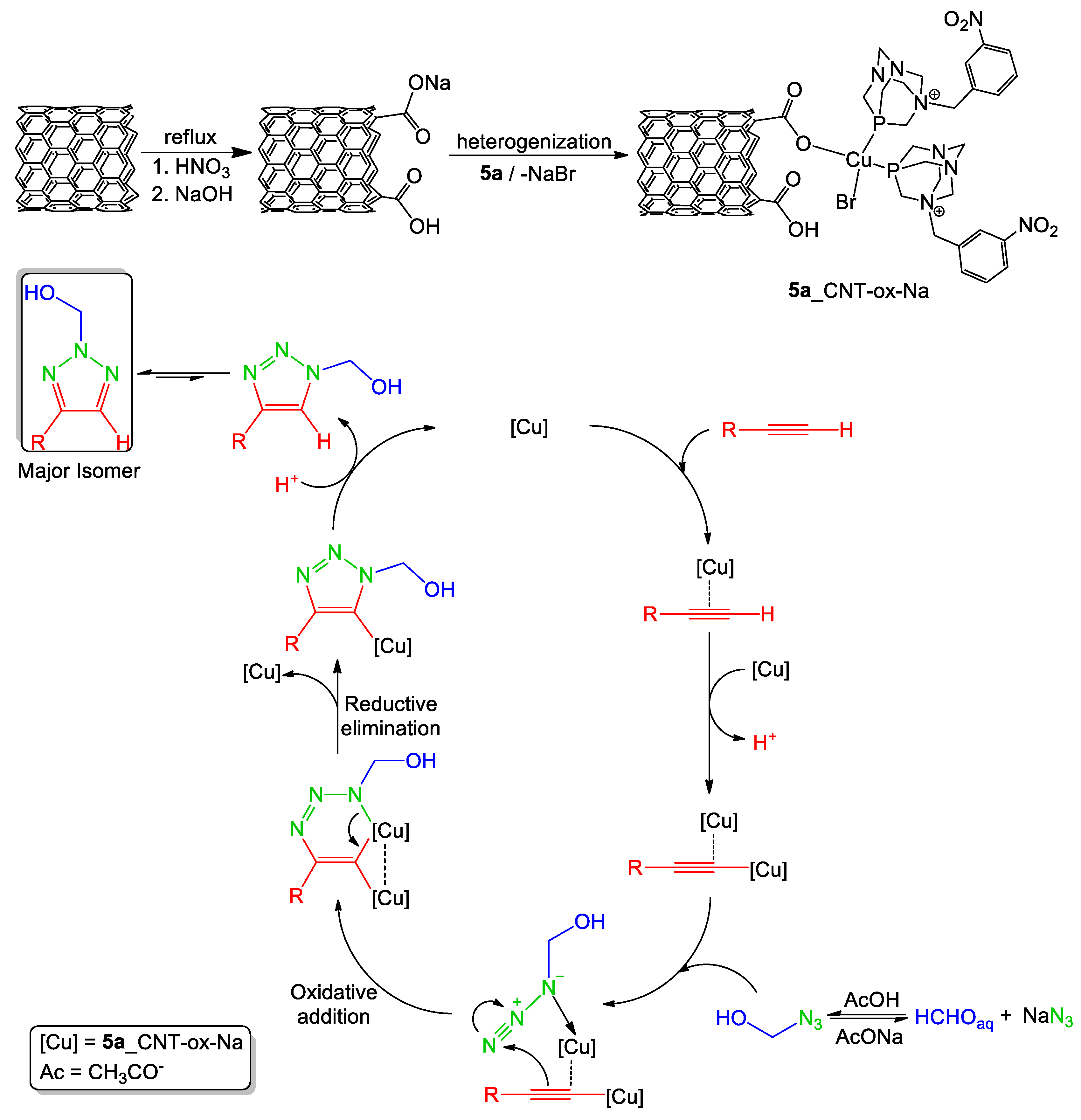
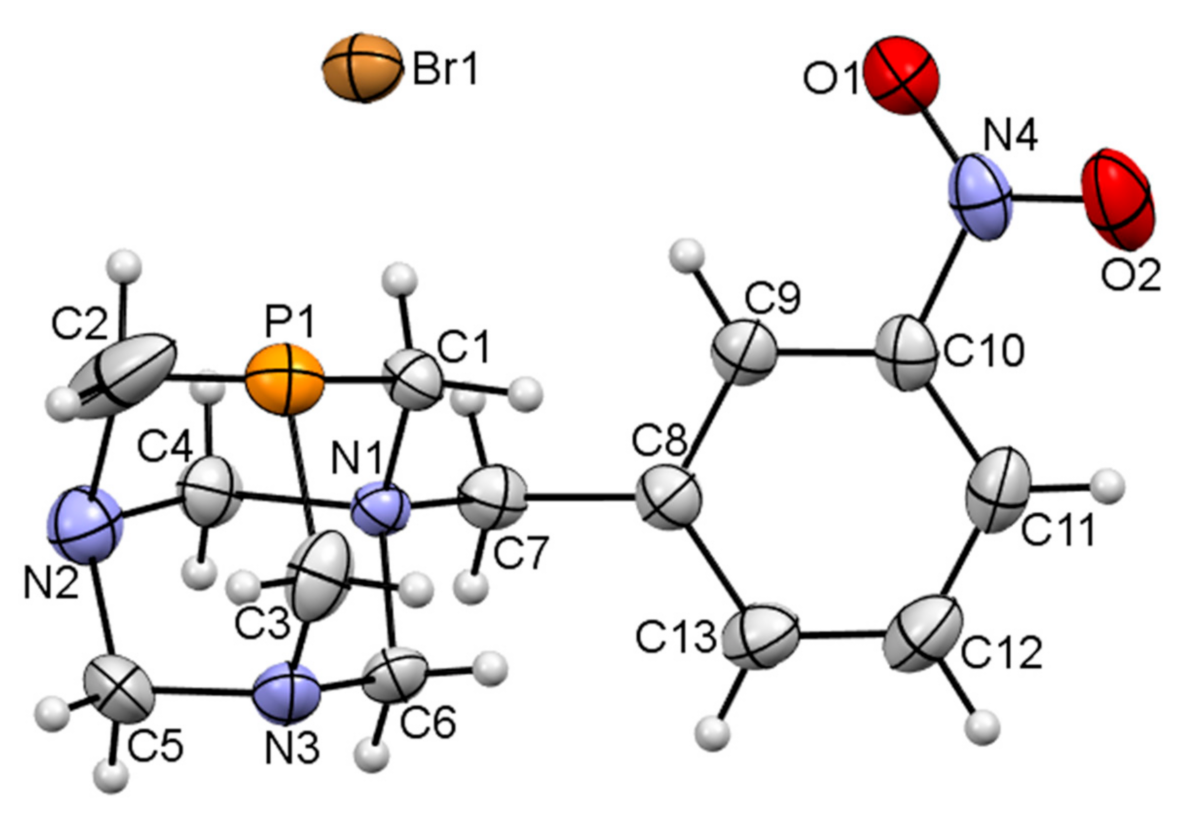

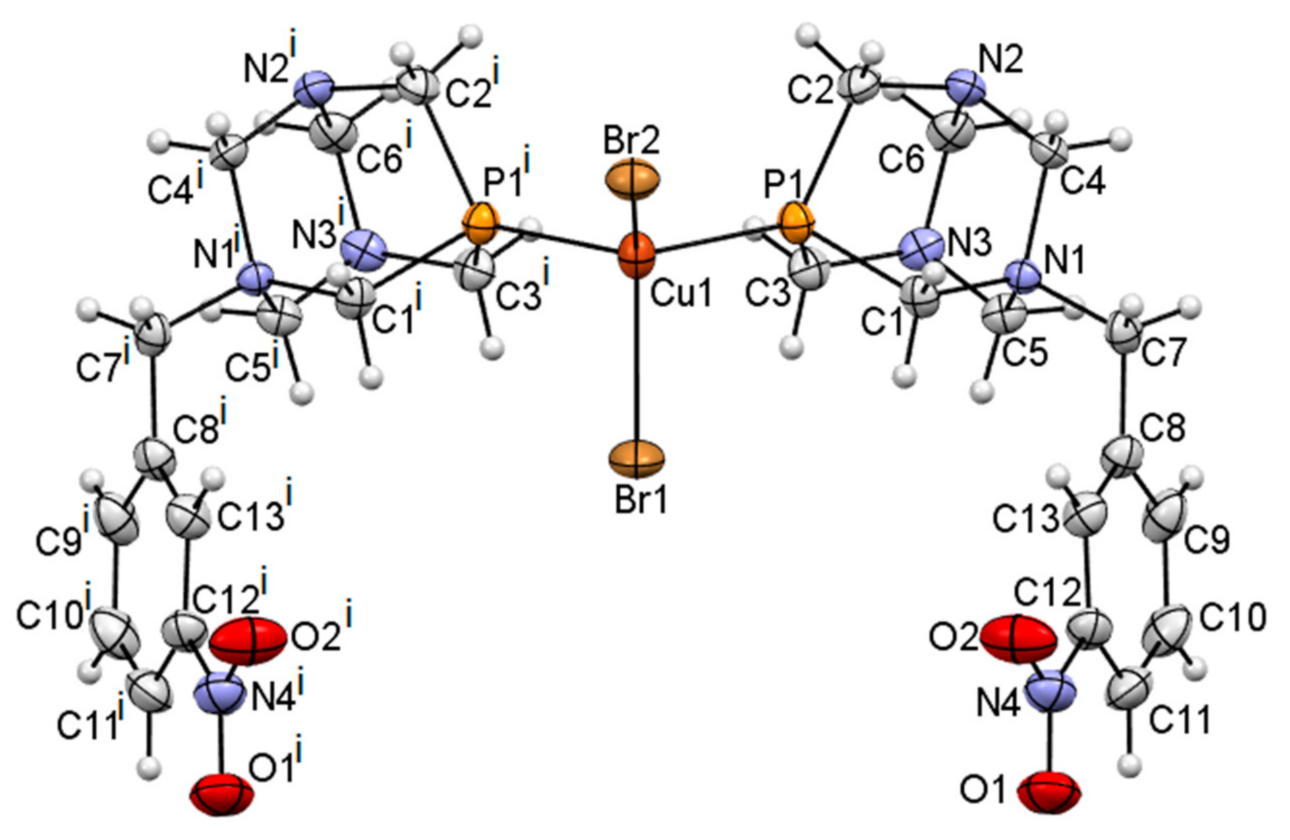
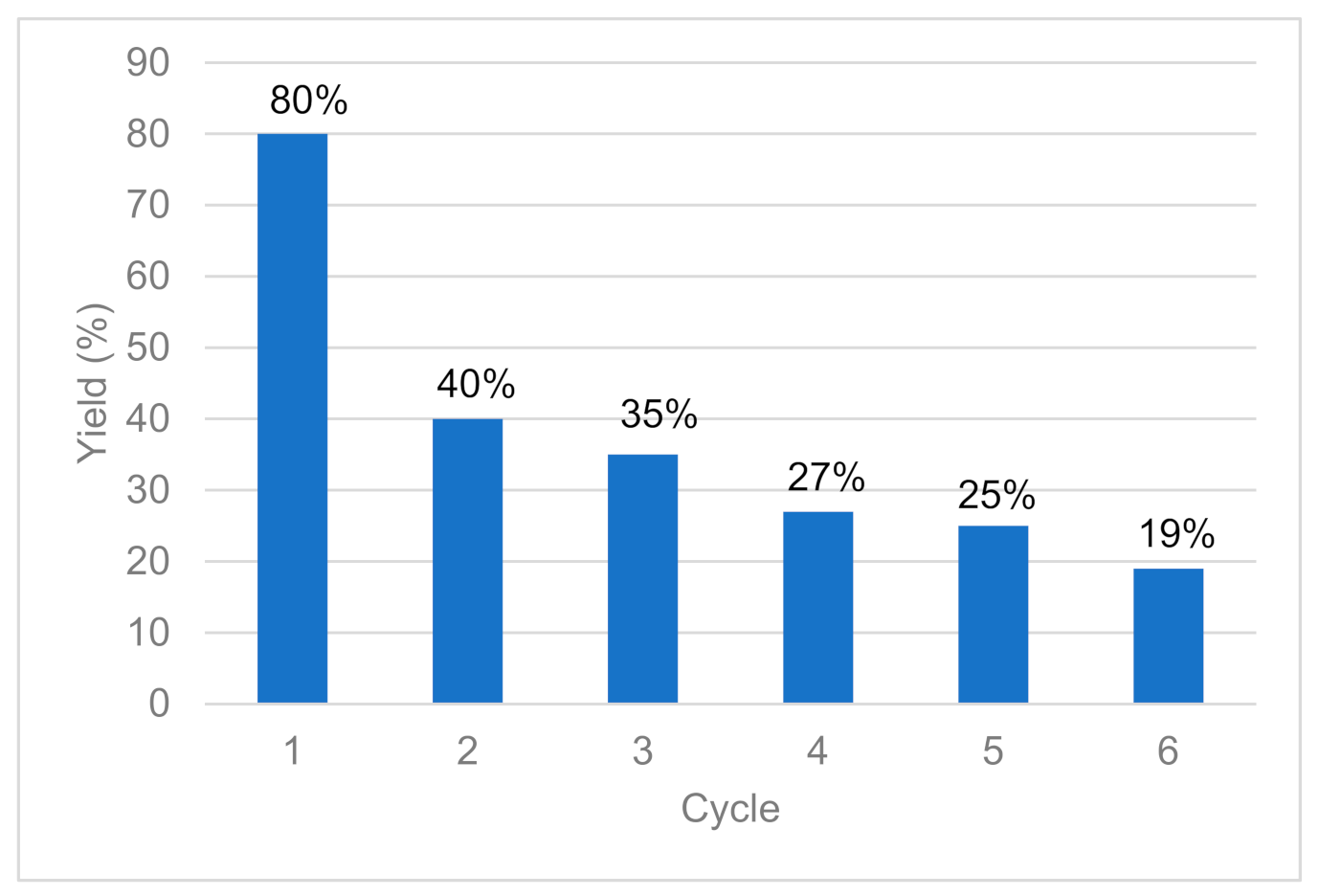
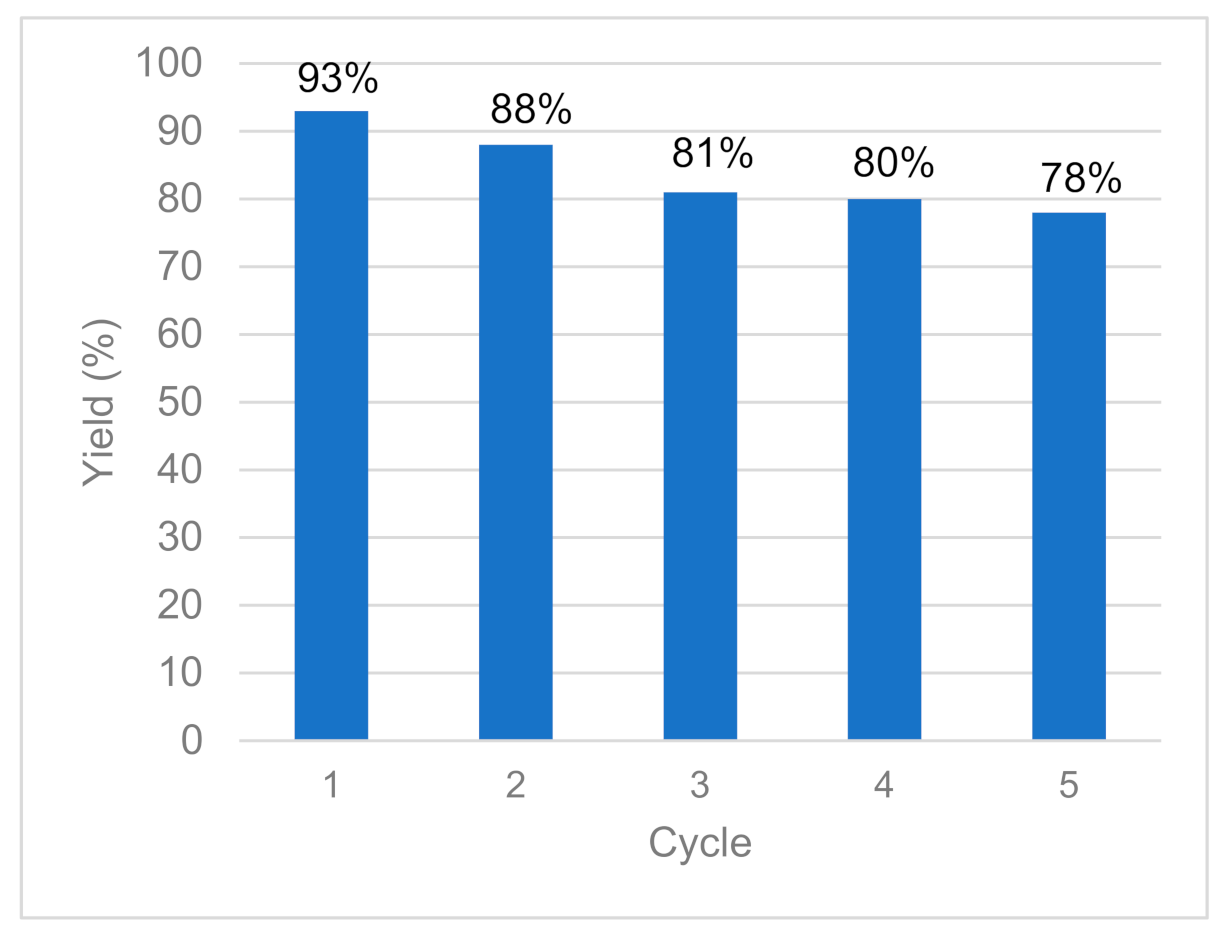
| 2 | 4 | 5a·3H2O | |||
|---|---|---|---|---|---|
| P1−C1 | 1.790(7) | Cu1−P1 | 2.271(2) | Cu1−P1 | 2.2282(9) |
| P1−C2 | 1.532(9) | Cu1−P2 | 2.261(1) | Cu1−Br1 | 2.4583(9) |
| P1−C3 | 1.690(8) | Cu1−P3 | 2.262(1) | Cu1−Br2 | 2.4283(8) |
| N1−C1 | 1.528(4) | Cu1−P4 | 2.272(2) | P1−C1 | 1.851(3) |
| N1−C4 | 1.522(4) | N4−C30 | 1.49(1) | P1−C2 | 1.837(4) |
| N1−C6 | 1.543(4) | N5−C33 | 1.50(1) | P1−C3 | 1.839(4) |
| N1−C7 | 1.514(4) | N10−C32 | 1.51(2) | N1−C1 | 1.503(4) |
| N2−C2 | 1.77(2) | N12−C17 | 1.48(1) | N1−C4 | 1.548(4) |
| N2−C4 | 1.52(2) | P1−Cu1−P2 | 110.52(6) | N1−C5 | 1.546(4) |
| N2−C5 | 1.59(2) | P1−Cu1−P3 | 111.04(6) | N1−C7 | 1.512(4) |
| N3−C3 | 1.465(5) | P1−Cu1−P4 | 106.56(6) | P1−Cu1−P1i | 116.17(5) |
| N3−C5 | 1.458(4) | P2−Cu1−P3 | 109.81(6) | P1−Cu1−Br1 | 102.68(3) |
| N3−C6 | 1.423(5) | P2−Cu1−P4 | 108.42(6) | P1−Cu1−Br2 | 113.40(3) |
| C7−C8 | 1.504(5) | P3−Cu1−P4 | 110.41(6) | Br1−Cu1−Br2 | 106.76(3) |
| C1−P1−C2 | 99.4(4) | C1−P1−C19 | 98.6(3) | C1−P1−C2 | 97.8(2) |
| C1−P1−C3 | 93.3(4) | C1−P1−C21 | 98.2(3) | C1−P1−C3 | 96.6(2) |
| C2−P1−C3 | 105.1(5) | C19−P1−C21 | 97.9(3) | C2−P1−C3 | 98.4(2) |
| C1−N1−C4 | 109.9(2) | C13−P2−C20 | 98.6(3) | C1−N1−C4 | 110.2(2) |
| C1−N1−C6 | 108.6(2) | C13−P2−C28 | 97.9(3) | C1−N1−C5 | 110.4(2) |
| C1−N1−C7 | 112.6(2) | C20−P2−C28 | 98.5(3) | C1−N1−C7 | 111.7(2) |
| C4−N1−C6 | 107.9(2) | C4−P3−C15 | 98.0(3) | C4−N1−C5 | 106.6(2) |
| C4−N1−C7 | 107.0(2) | C4−P3−C18 | 98.1(3) | C4−N1−C7 | 106.2(2) |
| C6−N1−C7 | 110.6(2) | C15−P3−C18 | 98.0(3) | C5−N1−C7 | 111.6(2) |
| C2−N2−C4 | 105(1) | C10−P4−C31 | 97.8(4) | C2−N2−C6 | 111.8(3) |
| C2−N2−C5 | 103(1) | C10−P4−C34 | 97.9(3) | C2−N2−C4 | 112.7(3) |
| C4−N2−C5 | 112(1) | C31−P4−C34 | 98.6(3) | C4−N2−C6 | 109.8(3) |
| C3−N3−C5 | 112.1(3) | C3−N3−C5 | 112.7(3) | ||
| C3−N3−C6 | 111.4(3) | C3−N3−C6 | 112.0(3) | ||
| C5−N3−C6 | 111.7(3) | C5−N3−C6 | 110.7(3) | ||
| N1−C7−C8 | 115.0(3) | N1−C7−C8 | 115.2(3) | ||
| Carbon Material | SBET (m2 g−1) | Pore Volume (cm3 g−1) | Pore Size (nm) |
|---|---|---|---|
| AC | 866 | 0.45 | 5.2 |
| AC-ox | 223 | 0.22 | 5.0 |
| AC-ox-Na | 191 | 0.15 | 4.9 |
| CNT | 257 | 2.44 | 30.8 |
| CNT-ox | 301 | 1.62 | 19.0 |
| CNT-ox-Na | 126 | 1.03 | 15.5 |
| Carbon Material | Cu Complex | |
|---|---|---|
| 5a | 5b | |
| AC | 1.61 | 0.21 |
| AC-ox | 1.60 | 1.05 |
| AC-ox-Na | 2.16 | 2.53 |
| CNT | 1.59 | 1.73 |
| CNT-ox | 1.56 | 1.64 |
| CNT-ox-Na | 1.87 | 2.2 |
 | |||
| Entry | Catalyst | Yield b (%) | TON c |
| 1 | 4 | 22 | 8 |
| 2 | 5a | 38 | 13 |
| 3 | 5b | 47 | 16 |
| 4 | 6a | 39 | 13 |
| 5 | 6b | 35 | 12 |
| 6 | 7a | 44 | 15 |
| 7 | 7b | 27 | 9 |
 | ||||||
| Entry | Catalyst Loading (mol%) | Time (min.) | Solvent | Total Volume of Solvent Mixture (mL) | Yield b (%) | TON c |
| 1 | 3 | 15 | H2O:1,4-dioxane | 1.0 | 71 | 24 |
| 2 | 3 | 15 | H2O:DMF | 1.0 | 51 | 17 |
| 3 | 3 | 15 | H2O:DMSO | 1.0 | 56 | 19 |
| 4 | 3 | 15 | H2O:MeCN | 1.0 | 84 | 28 |
| 5 | 3 | 15 | H2O:MeCN | 1.5 | 47 | 16 |
| 6 | 3 | 15 | H2O:MeCN | 0.5 | 92 | 31 |
| 7 | 3 | 60 | H2O:MeCN | 1.0 | 89 | 30 |
| 8 | 5 | 60 | H2O:MeCN | 0.5 | 99 | 20 |
 | ||||||
| Entry | Carbon Support | Catalyst Loading (mol %) | Time (min.) | Temperature (°C) | Yield b (%) | TON c |
| 1 | AC | 0.5 | 15 | 125 | 13 | 25 |
| 2 | AC-ox | 0.5 | 15 | 125 | 7 | 14 |
| 3 | AC-ox-Na | 0.5 | 15 | 125 | 10 | 20 |
| 4 | CNT | 0.5 | 15 | 125 | 24 | 47 |
| 5 | CNT-ox | 0.5 | 15 | 125 | 23 | 46 |
| 6 | CNT-ox-Na | 0.5 | 15 | 125 | 25 | 50 |
| 7 | CNT-ox-Na | 1.2 | 15 | 125 | 44 | 21 |
| 8 | CNT-ox-Na | 1.2 | 60 | 125 | 80 | 65 |
| 9 | CNT-ox-Na | 1.2 | 60 | 80 | 41 | 34 |
| Entry | Alkyne | Benzyl Bromide | Product | Yield b |
|---|---|---|---|---|
| 1 |  |  |  | 80 |
| 2 |  |  |  | 65 |
| 3 |  |  |  | 68 |
| 4 |  |  |  | 48 |
| 5 |  |  |  | 76 |
| 6 |  |  |  | 29 |
| 7 c |  |  |  | 43 |
| 8 c |  |  |  | 31 |
 | ||||
| Entry | Catalyst | Yield b (%) | Molar Ratio c (A:B) | TON d |
| 1 | 5a | 36 | 82:18 | 12 |
| 2 | 5b | 13 | 81:19 | 4 |
| 3 | 6a | 24 | 85:15 | 8 |
| 4 | 6b | 32 | 83:17 | 10 |
| 5 | 7a | 18 | 83:17 | 6 |
| 6 | 7b | 25 | 84:16 | 8 |
 | |||||||
| Entry | Catalyst Loading (mol %) | Time (min) | Temperature (°C) | Solvent | Yield b (%) | Molar Ratio (A:B) c | TON d |
| 1 e | 3 | 60 | 125 | H2O/dioxane | 25 | 85:15 | 8 |
| 2 | 3 | 15 | 125 | H2O/dioxane | 73 | 84:16 | 24 |
| 3 | 3 | 15 | 125 | H2O/MeCN | 47 | 86:14 | 16 |
| 4 | 3 | 15 | 125 | H2O/DMF | 48 | 83:17 | 16 |
| 5 | 3 | 15 | 125 | H2O/DMSO | 68 | 84:16 | 23 |
| 6 | 3 | 30 | 125 | H2O/dioxane | 78 | 84:16 | 26 |
| 7 | 3 | 60 | 125 | H2O/dioxane | 88 | 88:12 | 29 |
| 8 | 3 | 120 | 125 | H2O/dioxane | 75 | 85:15 | 25 |
| 9 f | 3 | 60 | 125 | H2O/dioxane | 75 | 84:16 | 25 |
| 10 | 3 | 15 | 80 | H2O/dioxane | 5 | 85:15 | 2 |
| 11 | 3 | 60 | 80 | H2O/dioxane | 57 | 83.17 | 19 |
| 12 | 5 | 15 | 125 | H2O/dioxane | 69 | 85:15 | 14 |
| 13 | 5 | 60 | 125 | H2O/dioxane | 85 | 84:16 | 17 |
 | ||||||
| Entry | Carbon Support | Catalyst Loading (mol %) | Temperature (°C) | Yield b (%) | Molar Ratio (A:B) c | TON d |
| 1 | AC | 2 | 125 | 48 | 91:09 | 23 |
| 2 | AC-ox | 2 | 125 | 71 | 90:10 | 34 |
| 3 | AC-ox-Na | 2 | 125 | 28 | 94:06 | 14 |
| 4 | CNT | 2 | 125 | 17 | 85:15 | 8 |
| 5 | CNT-ox | 2 | 125 | 39 | 85:15 | 19 |
| 6 | CNT-ox-Na | 2 | 125 | 86 | 88:12 | 42 |
| 7 | CNT-ox-Na | 0.5 | 125 | 45 | 88:12 | 92 |
| 8 | CNT-ox-Na | 2.5 | 125 | 93 | 88:12 | 38 |
| 9 | CNT-ox-Na | 2.5 | 80 | 33 | 95:05 | 13 |
Publisher’s Note: MDPI stays neutral with regard to jurisdictional claims in published maps and institutional affiliations. |
© 2021 by the authors. Licensee MDPI, Basel, Switzerland. This article is an open access article distributed under the terms and conditions of the Creative Commons Attribution (CC BY) license (https://creativecommons.org/licenses/by/4.0/).
Share and Cite
Librando, I.L.; Mahmoud, A.G.; Carabineiro, S.A.C.; Guedes da Silva, M.F.C.; Geraldes, C.F.G.C.; Pombeiro, A.J.L. Synthesis of a Novel Series of Cu(I) Complexes Bearing Alkylated 1,3,5-Triaza-7-phosphaadamantane as Homogeneous and Carbon-Supported Catalysts for the Synthesis of 1- and 2-Substituted-1,2,3-triazoles. Nanomaterials 2021, 11, 2702. https://doi.org/10.3390/nano11102702
Librando IL, Mahmoud AG, Carabineiro SAC, Guedes da Silva MFC, Geraldes CFGC, Pombeiro AJL. Synthesis of a Novel Series of Cu(I) Complexes Bearing Alkylated 1,3,5-Triaza-7-phosphaadamantane as Homogeneous and Carbon-Supported Catalysts for the Synthesis of 1- and 2-Substituted-1,2,3-triazoles. Nanomaterials. 2021; 11(10):2702. https://doi.org/10.3390/nano11102702
Chicago/Turabian StyleLibrando, Ivy L., Abdallah G. Mahmoud, Sónia A. C. Carabineiro, M. Fátima C. Guedes da Silva, Carlos F. G. C. Geraldes, and Armando J. L. Pombeiro. 2021. "Synthesis of a Novel Series of Cu(I) Complexes Bearing Alkylated 1,3,5-Triaza-7-phosphaadamantane as Homogeneous and Carbon-Supported Catalysts for the Synthesis of 1- and 2-Substituted-1,2,3-triazoles" Nanomaterials 11, no. 10: 2702. https://doi.org/10.3390/nano11102702
APA StyleLibrando, I. L., Mahmoud, A. G., Carabineiro, S. A. C., Guedes da Silva, M. F. C., Geraldes, C. F. G. C., & Pombeiro, A. J. L. (2021). Synthesis of a Novel Series of Cu(I) Complexes Bearing Alkylated 1,3,5-Triaza-7-phosphaadamantane as Homogeneous and Carbon-Supported Catalysts for the Synthesis of 1- and 2-Substituted-1,2,3-triazoles. Nanomaterials, 11(10), 2702. https://doi.org/10.3390/nano11102702











